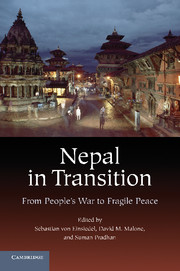Book contents
- Frontmatter
- Contents
- Contributors
- Acknowledgments
- 1 Introduction
- The Context
- 2 The Making of the Maoist Insurgency
- 3 State Power and the Security Sector: Ideologies and Interests
- 4 The Legacy of Nepal's Failed Development
- 5 Ethnic Politics and the Building of an Inclusive State
- Critical Transition and the Role of Outsiders
- Regional Dynamics
- Conclusions
- Index
- References
4 - The Legacy of Nepal's Failed Development
Published online by Cambridge University Press: 05 April 2012
- Frontmatter
- Contents
- Contributors
- Acknowledgments
- 1 Introduction
- The Context
- 2 The Making of the Maoist Insurgency
- 3 State Power and the Security Sector: Ideologies and Interests
- 4 The Legacy of Nepal's Failed Development
- 5 Ethnic Politics and the Building of an Inclusive State
- Critical Transition and the Role of Outsiders
- Regional Dynamics
- Conclusions
- Index
- References
Summary
The economic trajectory of so-called developing countries is far from uniform. Some of these countries have been truly developing, favorably affecting, in the reckoning of economist Paul Collier, the lives of four billion people over the past six decades. A dozen or so have made miraculous progress in a relatively short period and have graduated to the status of developed or near-developed countries. However, a significant number of these countries, particularly in Africa, are not developing at all – trapping one billion people in poverty, despair, and conflict. With its record of failed development, Nepal belongs to this last group. Its failed development is mainly due to social and cultural rigidities that have maintained traditional power relations and underlying social norms despite the political changes since the 1950s. The outcomes of the contests between different interests currently testing the ongoing political transition will ultimately determine whether the country can break away from the grip of the status quo.
This chapter explores the nature of Nepal's failed development, identifies causative factors, and discusses possibilities for a course reversal. First, it explains the syndrome of failed development and examines the country's development record. Then it focuses on macroeconomic outcomes and some indicators of social and human development, as well as their distribution across different sections of the population. Nepal's political and institutional features that bear on its legacy of failed development and its future course are of special concern. The role of international partners, including India, in Nepal's development and peacebuilding efforts is also discussed. The chapter concludes with some suggestions for a behavioral shift that should allow Nepal to escape the failed development paradigm.
- Type
- Chapter
- Information
- Nepal in TransitionFrom People's War to Fragile Peace, pp. 81 - 128Publisher: Cambridge University PressPrint publication year: 2012
References
- 7
- Cited by



